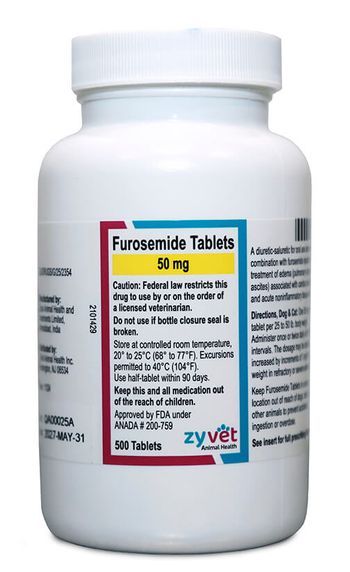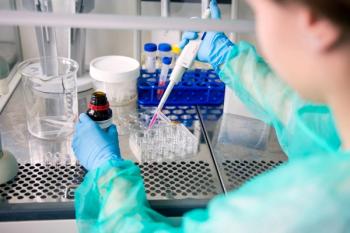
Reviewing causes, treatment of feline lymphadenopathy
Please review the various causes of abdominal lymphadenopathy in cats.
Q: Please review the various causes of abdominal lymphadenopathy in cats.
A: Dr. John R. August gave an excellent lecture entitled "Abdominal Lymphadenopathy in Cats: A Diagnostic Challenge" at the 2008 American College of Veterinary Internal Medicine Forum in San Antonio.
Here are some relevant points from his lecture:
Abdominal lymphadenopathy, or masses that may be confused with enlarged lymph nodes, are common clinical findings in sick cats, either on physical examination or via ultrasonography. Many inflammatory, infectious and neoplastic diseases can cause enlargement of regional lymph nodes in the abdomen. Assessment of lymph-node size and cytologic or histopathologic characteristics may provide important information when more invasive diagnostic methods are not available. As with all sick cats, the history and physical examination are necessary to identify additional clinical abnormalities that may clarify the cause of the lymphadenopathy.
Causes of lymphadenopathy
Lymph nodes that are palpable in healthy cats and dogs include the mandibular, superficial cervical, axillary, superficial inguinal and popliteal nodes. Lymphadenopathy is defined as enlargement of a solitary node, a regional group of nodes or of all lymph nodes. Causes of lymph-node enlargement in cats include:
- REACTIVE HYPERPLASIA, resulting from proliferation of lymphocytes and plasma cells from antigenic stimulation
- LYMPHADENITIS, resulting from an influx of inflammatory cells due to local infection
- NEOPLASTIC INFILTRATION, either from primary lymphoid neoplasia or from infiltration from metastatic neoplastic disease.
Differential diagnosis
Abdominal lymphadenopathy in cats may represent a response to a local disease process within the abdominal cavity or may be a component of a systemic disease accompanied by generalized lymph-node enlargement.
Organomegaly, most often associated with small-intestinal masses, but also due to splenomegaly or hepatomegaly, may accompany abdominal lymph-node enlargement, complicating the accurate identification of lymphadenomegaly on palpation.
Reactive mesenteric lymph-node hyperplasia is a common ultrasonographic abnormality, but less common physical finding, in cats with inflammatory bowel disease. The degree of thickening of the small intestine and the degree of lymphadenomegaly correlate well with the severity of the disease. Clinical signs include vomiting, diarrhea, weight loss, reduced appetite and poor body condition and haircoat.
Intestinal tumors occur commonly in cats, accounting for 35 percent of all feline tumors. Approximately 74 percent of all feline intestinal tumors are the result of lymphoma, with intestinal adenocarcinomas being the cause of an additional 17 percent of intestinal neoplasia.
An abdominal mass is detected by palpation in 86 percent of cats with intestinal lymphoma, with lymphoblastic lymphoma being more likely to induce discrete masses. The small intestine is the most common site of lymphoma in cats, followed by the stomach, ileocolic junction and lastly the colon.
Diffuse intestinal thickening is more common in low-grade lymphocytic lymphoma. Concurrent mesenteric lymphadenopathy is noted ultrasonographically in 33 percent to 50 percent of cats with alimentary lymphoma, intestinal masses or thickening in about 40 percent of affected cats, and splenomegaly, hepatomegaly or abdominal effusion in a smaller number of cats.
Abdominal lymphadenopathy is a prominent feature of feline infectious peritonitis (FIP), especially the non-effusive form of the disease. In a series of 156 cats with FIP, 26 (16 percent) had an unusual manifestation of the disease, characterized by the presence of an isolated intramural intestinal mass, with local lymphadenomegaly.
The nodular pyogranulomatous intestinal lesions were found most commonly in the colon (45 percent), ileocolic junction (31 percent) and small intestine (16 percent). Only one segment of intestine was affected in each cat. At surgery, many of the lesions were mistaken for primary intestinal neoplasia. Ultimately, all affected cats developed multisystemic signs of FIP, suggesting that the localized lesions were the result of temporary containment of infection by a partial cell-mediated immune response to the pathogenic coronavirus.
Several other infectious diseases may be associated with abdominal lymph-adenomegaly in cats, manifested either as regional lymphadenopathy or as part of a generalized lymph-node enlargement. Histoplasma capsulatum infections in cats commonly cause peripheral and abdominal lymphadenopathy and may be difficult to differentiate from those caused by non-effusive FIP or retrovirus infections in some cats. Clinical signs include weight loss, pyrexia, dyspnea, tachypnea, splenomegaly, hepatomegaly, anemia and ocular, osseous and cutaneous lesions.
Acute infections or recrudescence of latent infections with Toxoplasma gondii may cause signs similar to those resulting from generalized histoplasmosis, and may include the development of focal intestinal masses and mesenteric lymphadenopathy.
Infections with tuberculous myco-bacteria (especially Mycobacterium bovis) in cats may cause primary intestinal disease with concurrent ileocecal and mesenteric lymphadenomegaly and splenic and hepatic involvement. Non-tuberculous mycobacterial (Myco-bacterium avium complex) infections in cats may cause visceral disease, with thickened intestines, mesenteric lymphadenopathy and hepatosplenomegaly as prominent signs.
Methicillin-resistant staphylococcal infections occasionally may cause disseminated disease in cats, including abdominal lymphadenomegaly. The role of Ehrlichia species in causing overt disease in cats remains unclear; however, reported clinical signs are similar to those described earlier for histoplasmosis, with the exception of the pulmonary changes.
Signalment and history
Abdominal lymphadenomegaly in juvenile or young adult sick cats most likely is associated with an infectious disease; for example, FIP, histoplasmosis or toxoplasmosis. Infiltrative intestinal diseases, whether inflammatory or neoplastic, are more likely to be the cause of visceral lymphadenopathy in mature or senior cats. Exceptions to these observations are common, however. Young pure-bred cats acquired from catteries within the past several months, and whose clinical signs include prominent abdominal lymph-node enlargement, should be evaluated carefully for feline infectious peritonitis.
The geographic location of where the cat has been living should be determined, because some diseases that cause abdominal lymphadenopathy (for example, infections caused by Histoplasma capsulatum and Francisella tularensis) are regional in their distribution.
Physical examination
A physical examination is an important part of the complete evaluation of the cat found to have abdominal lymphadenopathy on cursory examination or via ultrasonographic evaluation. The presence of persistent fever suggests an infectious, inflammatory process, although this abnormality may be noted in neoplastic disease.
A thorough ocular examination is an important and often overlooked component of the comprehensive evaluation of affected cats, because several infectious diseases causing lymphadeno-megaly may induce inflammatory ocular changes that provide important diagnostic information. Detection of peripheral lymphadenopathy, in addition to visceral lymphadenomegaly, is suggestive of a disseminated infectious or neoplastic disease.
Pain on palpation of enlarged abdominal lymph nodes is more likely to result from lymphadenitis than from reactive hyperplasia or neoplastic infiltration. Concurrent thickening of intestinal loops may be associated with inflammatory, infectious or neoplastic infiltrative diseases.
Laboratory evaluation
Comprehensive laboratory evaluation of cats with unexplained abdominal lymphadenopathy should include complete blood count, serum chemistry profile, urinalysis, tests for feline leukemia virus antigen and feline immunodeficiency virus antibody and complete fecal parasitological examination.
Additional serologic tests, based on a cat's signalment and clinical signs, include IgM and IgG titers for Toxoplasma gondii, baseline feline coronavirus antibody titer (to exclude infection), and urine antigen titers for Histoplasma capsulatum when no organisms have been identified.
Additional polymerase chain-reaction (PCR) testing on blood, lymph-node aspirates, body-cavity effusion and feces may be indicated in coronavirus-seropositive cats in which the suspicion of FIP is high. Serologic evaluation for Ehrlichia canis-like organisms may be performed when more common causes of systemic illness and visceral lymphadenomegaly have been excluded.
Serum cobalamin and serum folate levels, in combination with serum trypsin-like immunoreactivity levels, should be performed when concurrent weight loss and gastrointestinal signs (including thickened intestinal loops) are noted. In a recent study, 78 percent of cats with low-grade lymphocytic lymphoma were found to have decreased cobalamin levels; mesenteric lymph-node involvement was noted in six of 41 affected cats.
Diagnostic imaging
Ultrasound evaluation is considered more sensitive than survey radiography for detecting the presence of abdominal lymphadenomegaly; however, it is not sensitive for the identification of the underlying cause of the lesions. Fine-needle aspirates or biopsies of lymph nodes are needed to clarify the ultrasonographic changes.
Abdominal lymph nodes are classified as visceral or parietal, according to the anatomic area that they drain. Visceral lymph nodes include the jejunal nodes (also known as the cranial mesenteric nodes) and the right colic lymph nodes, both of which are often enlarged in inflammatory bowel disease or alimentary lymphoma. Ultra-sonographic evidence of abdominal lymphadenopathy has been found in up to 50 percent of cats with alimentary lymphoma, with intestinal masses being identified sonographically in about 40 percent of affected cats.
Ultrasonographic parameters that are useful to distinguish normal from abnormal lymph nodes include nodal size, shape, margin characteristics, echogenicity, echotexture, acoustic transmission, the presence of vascular flow and its distribution and the measurement of vascular flow indices.
Doppler evaluation of the abdominal lymph nodes of cats with alimentary lymphoma may show aberrant blood vessels entering the nodes in abnormal locations, in comparison to normal lymph nodes in which the hilus is the usual point of entry. On a practical basis, the parameters that provide the best predictability are the size and shape of the lymph node(s), the distribution of vessels within the node and the pulsatility index that reflects vascular resistance within the node.
Cytologic evaluation
Small lymphocytes comprise 75 percent to 90 percent of the lymphocyte population obtained from normal lymph nodes, with medium-sized lympho-cytes contributing 5 percent to 15 percent, and lymphoblasts 5 percent. Hyperplastic lymph nodes have the same respective lymphocyte counts as normal lymph nodes; however, nodal size is increased.
Reactive lymphadenopathy is characterized by a small to moderate increase in the numbers of prolymphocytes, lympho-blasts and plasma cells. Both of these cytologic findings are considered to be the result of lymphoid proliferation in response to antigenic stimulation.
Lymphadenitis is characterized by an increase in inflammatory cells, including neutrophils, macrophages and eosinophils. The response is classified as primary if the lymph node is infected and secondary if the lymph node is not infected but is draining an infected lesion in its region.
Lymphoblasts usually comprise at least 50 percent of the cell population in lymph nodes from cats with lymphoblastic lymphoma. Mesenteric lymph-node aspirates from cats with low-grade lymphocytic lymphoma may yield a homogeneous population of small lymphocytes, in the absence of normal numbers of precursor cells.
Biopsy and histopathologic examination may be necessary to confirm the diagnosis of lymphoma. PCR testing to detect the presence of a clonal lympho-cyte population also may be useful to confirm the cytologic or histo-pathologic findings.
Dr. Hoskins is owner of Docu-Tech Services. He is a diplomate of the American College of Veterinary Internal Medicine with specialities in small animal pediatrics. He can be reached at (225) 955-3252, fax: (214) 242-2200 or e-mail:
Newsletter
From exam room tips to practice management insights, get trusted veterinary news delivered straight to your inbox—subscribe to dvm360.






